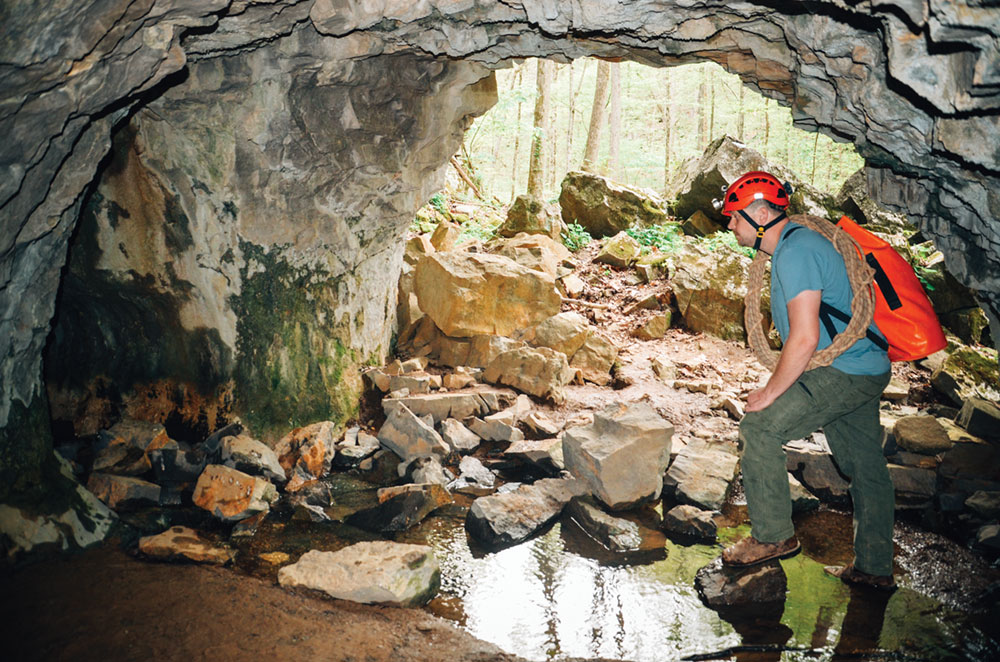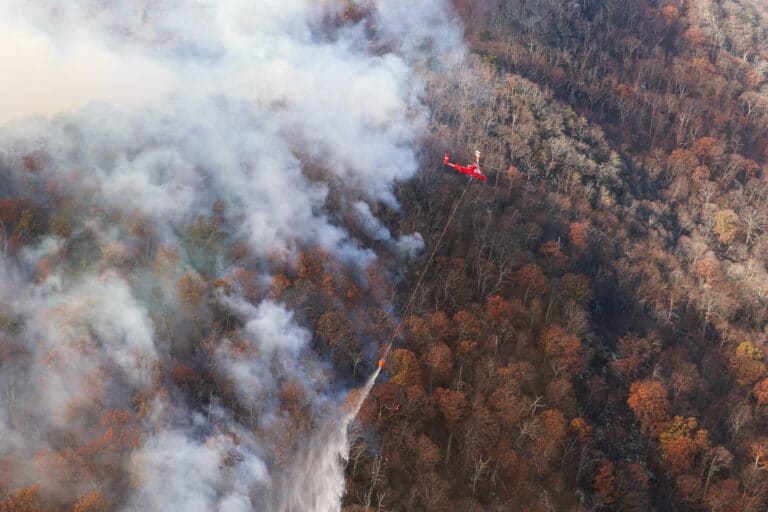An expert caver offers insight into exploring what’s underneath
Cavers have a reputation for being kind of weird. Their recreation takes place in darkness, where it’s cold and wet with tight squeezes, conditions for which most people have a deep and innate aversion. Throw in dizzying heights and complete isolation from the outside world, and it’s easy to see why it takes a special type of person to enjoy crawling into a hole in the ground.
Yet cavers are secretive, as if putting the word out would send throngs of tourists into the earth to experience a lifestyle best suited to salamanders. That’s the conundrum caver Chris Baty struggles with. On one hand, caves are extremely delicate places, where human visitors can permanently mar beauty that has slowly formed over millions of years. On the other hand, the skills and techniques of caving must be passed down if the sport is to survive.
Twenty years ago, Baty explored his first wild cave as a 13-year-old Boy Scout. Local caver Bush Middleton volunteered to take a bunch of rowdy scouts into Pettyjohn’s Cave, just outside their small hometown of LaFayette, Ga. The experience stuck with Baty, who continued deeper into the sport as one by one his caving buddies moved on to other pursuits.
At 33, Baty is now a trained and certified member of Walker County, Georgia’s Cave and Cliff Rescue Team. Always on call, the team has been pulling people out of holes and off cliff faces since it formed from a caving club in the 1970s. Today, the team of 15 to 20 volunteers is embedded within the county’s fire department, where cross-training has developed a roster of firefighters, EMTs, and outdoor enthusiasts equipped to carry out search and rescue in extreme environments.
The team evolved out of necessity in an area rich with resources for adventurous people. In the low mountains of northwest Georgia, Walker County is part of a rugged region referred to as TAG Corner. TAG is where Tennessee, Alabama and Georgia meet. Here, on the southern end of the Cumberland Plateau, eons of geology have created an outdoor playground that calls to climbers with acres of boulder gardens and long bands of high sandstone cliffs.
For cavers, adventure lies beneath the sandstone, where 300 million years ago an ancient sea deposited a layer of sediment that hardened to limestone. Over geologic time, rainwater seeping through the soil carved out a subterranean world in the limestone karst. There are more than 14,000 known caves in TAG, and likely more waiting to be discovered.
“TAG’s special,” said Baty. “There’s a lot of people who move to TAG just for it. There’s people who come from all over the world to experience it.”
A feature that makes TAG special is the thickness of the karst. With a limestone layer more than 500 feet deep, the region is renowned for vertical caves, where underground waterfalls spill into deep pits and the rope work of cave exploration is extremely technical, like underground mountaineering.
The region is an epicenter for vertical caving. Huntsville, Ala. is the headquarters of the National Speleological Society. Pigeon Mountain Industries (PMI), in LaFayette, pioneered the market for burly, almost indestructible caving ropes. Baty said he knows and trusts his neighbors who make his ropes and stitch his harnesses.
Walker County’s Ellison’s Cave features the two deepest free-fall pits in the continental United States. The cave system spreads over 12 miles and more than 1,000 vertical feet. Fantastic Pit is the headliner pitch, with a spectacular 586-foot rappel to the cave floor. Obviously, it is not a place for beginners.
Every few years, the Cliff and Cave Rescue Team, along with members and resources from other regional rescue organizations, are called upon to descend Ellison’s and haul someone out. And Ellison’s is just one of many regional caves where rescues are needed. Baty said the team is called out about once a month, sometimes to caves, sometimes to cliffs, and sometimes to find lost hikers.
The thing about cave rescue is the environment makes everything more difficult. Many times injuries are severe, communication with the outside world is impossible, and hypothermia is a constant danger. In 2011, two college students died of hypothermia in Ellison’s Cave when they were trapped in a waterfall by their rappelling ropes.
Symptoms of hypothermia include disorientation and loss of coordination that amplify the danger of an already precarious environment. This can occur in just a few minutes, and cave rescue is not a speedy process.
“There’s nothing fast about cave rescue,” said Baty. “If you fall an hour in, it takes your buddy an hour to get out and even longer to get to cell service.”
And that’s just to put out a call for help.
Baty recalled his first cave rescue four years ago. A man had stumbled into a 30-foot pit while exploring Byer’s Cave in Dade County, Georgia. He suffered severe head and chest injuries inside a challenging cave known for extremely tight spaces and vertical drops. It took 12 hours for rescuers to stabilize the man, “package” him in a basket, and devise an elaborate system of ropes and pullies to transport him to the surface. According to a local news report, rescuers had to rig three separate vertical hauls and a high-line traverse system to carry the man out of the cave.
All of that rope work is part of the reason Baty enjoys exploring vertical caves. He said the knowledge he’s gained from the rescue team, as well as through coursework with the National Cave Rescue Commission, has expanded his abilities and increased his enjoyment of cave exploration. With a limit on the amount of gear it’s feasible to carry, vertical caving is three-dimensional problem solving. Knots and equipment are important, and so are spatial awareness, an ability to improvise, and mental acuity.
“I like how it mentally and physically keeps me sharp,” Baty said. “You need to be 100 percent sure with yourself… You need to pay really close attention to yourself, ask yourself if you’re thinking clearly. And you have to watch your buddy, too.”
And a trusted buddy is essential. Like trad climbing, caving is a team sport. Those interested in giving it a try, however, might have trouble finding a mentor, because the sport is… well… underground. It’s not a visible activity that encourages publicity or showboating.
“We get nasty; we’ve got mud all over our faces; we’ve got bat shit on us,” Baty said. “We come out and our T-shirts are ripped. Most of us look like we’re homeless when we’re going. It’s just a bunch of ratted, tatted ol’ people. We don’t do it to look cool, that’s for sure. It’s like the hidden sport, almost.”
The National Speleological Society is a resource to find cavers. There are regional groups where it’s possible to meet like-minded people and lifelong friends. Although stressing that he is by no means the most experienced or knowledgeable caver out there, Baty tries to pass on his love of the sport by taking local Boy Scouts into the ground, like Middleton did two decades ago.
“It’s a craft, and it really needs to be passed down to responsible people,” Baty said. “It will die if it’s not carried on. I think it’s really cool that a man took me, and now I’m in this county doing the same thing. That kind of inspires me. Maybe I might influence somebody like that?”
If nothing else, Baty is showing those scouts something not too many people have an opportunity to experience.
Cover photo: Chris Baty explores the more than 14,000 known caves in the rugged area where Tennessee, Georgia, and Alabama meet. photo by Nick Carter








